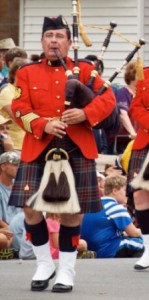Piper of Pageantry
 Canadian piper Wayne Moug has deep Celtic Roots; his father emigrated from Scotland following World War II, and his mother’s family came to Canada from Massachussetts following the American Revolution. Here, he explains his passion for piping and his involvement with this year’s Royal Nova Scotia International Tattoo.
Canadian piper Wayne Moug has deep Celtic Roots; his father emigrated from Scotland following World War II, and his mother’s family came to Canada from Massachussetts following the American Revolution. Here, he explains his passion for piping and his involvement with this year’s Royal Nova Scotia International Tattoo.
I first became involved with the Tattoo in 1981 while working at the Halifax Citadel National Historic Site when some of our costumed interpreters were used in one of the stage scenes. In subsequent years I participated as a piper with my band, as a liaison officer for visiting bands and as a consultant to the costume department. Presently I am the Director of Pipes and Drums and will be playing with the Black Watch Association Pipes & Drums.
There are many rewards, including the thrill of being involved in one of the largest productions of its kind in the world, having the opportunity to perform to an enthusiastic crowd at each show, getting immediate feedback on the quality of the performance, and meeting other participants from across North American and, in fact, around the world.
While not visible to many people the spin off impact on regional tourism and identity is huge. Visitors from across Canada and many other countries come to see the show and the Tattoo is only one of the events or activities they will take in. While here they will explore the province, experience our heritage, shop at local stores, dine at local restaurants and stay in a wide range of accommodations. The Tattoo allows us to showcase Nova Scotia and Canadian talent and history and we can honour those who have served or are serving our country in the Armed Forces, police and other emergency services.
I primarily am involved with the piping community as a player, teacher, organizer, and advocate. A recent initiative by the Nova Scotia Tattoo Foundation is the promotion of piping and drumming instruction around the province and I have been asked to implement this initiative.
I think one can always do more. We are rather fortunate in Nova Scotia in that we have a vibrant Celtic music scene, most often associated with Cape Breton but certainly evident on the mainland as well. Fiddling, piping, dancing and language are all available to those who wish to seek them out. However, many other activities compete for our time, especially for young people who have a myriad of options thrown at them daily. Visibility is key, we have to put ourselves ‘out there’.



















Leave a Comment